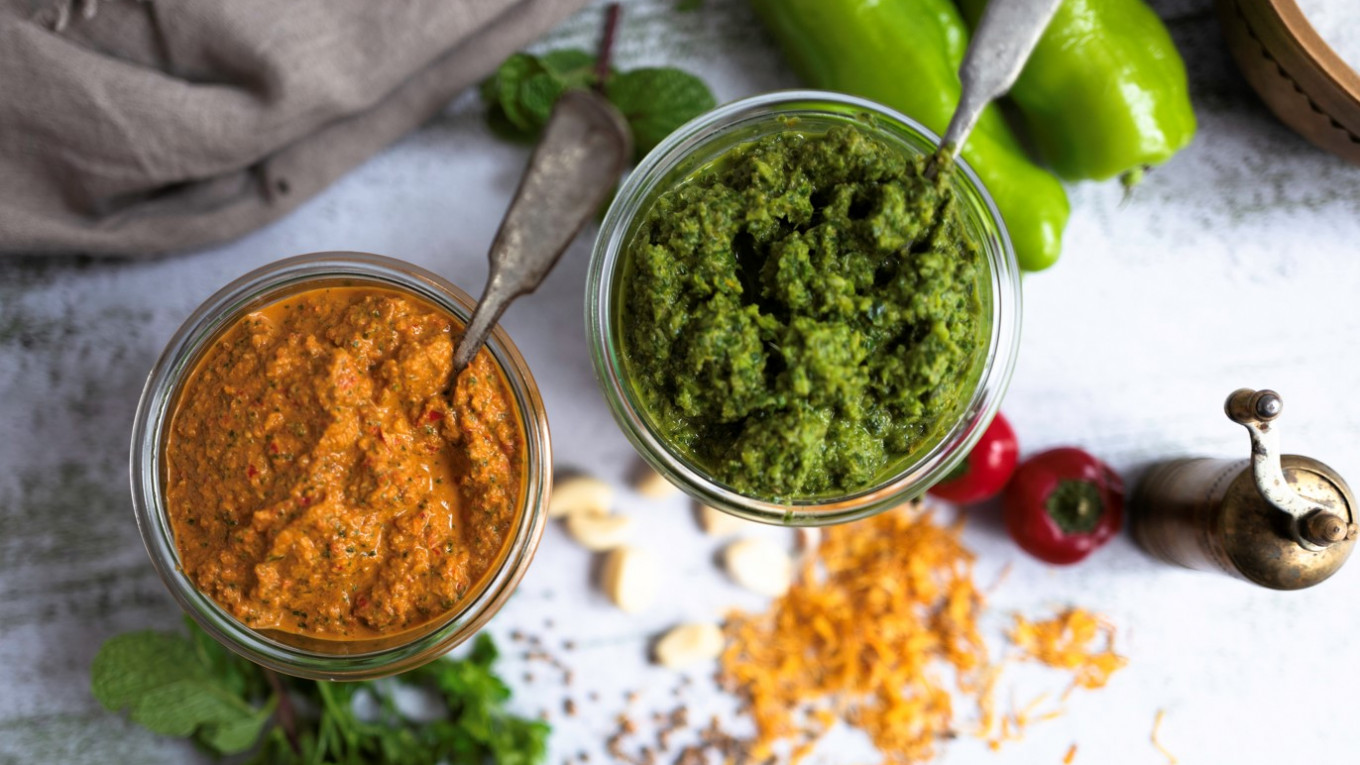This week I gave the fridge a very thorough going over, the kind of special operation where I take absolutely everything out, and give the shelves and drawers a good scrub, as well as the sticky collection of jars that crowd my top shelf. It did not surprise me to find three almost empty jars of adjika, which, alas, could not be combined, as they were all different. I threw the contents of the spiciest into a plastic bag of marinating pork, smeared the other on a grilled cheese sandwich for lunch, and mixed the third together with kefir and lemon juice to make salad dressing. And as I did so, it reminded me of how versatile and enjoyable adjika can be.
But what is adjika exactly?
I’ve heard adjika called everything from “Georgian pesto,” to “Russian salsa,” to “Kyrgyz harissa.” Adjika is none of these things, of course, though harissa is the closest analogy. Adjika is a chili paste, tempered with garlic, salt, and a few signature Caucasian spices. Though the Georgians have eagerly claimed this beloved regional condiment as their own, adjika is originally from Abkhazia, the autonomous republic of the South Caucasus, which, come to think of it, the Georgians also claim as their own.
Adjika in Abkhaz means “salt,” and the condiment’s story begins with Abkhazian shepherds, who fed salt to their grazing sheep to increase their appetites and thus fatten them up. Because salt was an expensive commodity, the shepherds mixed it with the region’s ubiquitous red peppers, later adding wild herbs and garlic to the mixture. The best adjika is hand ground with stones, though today, most people take the straightforward route and use a food processor or meat grinder.
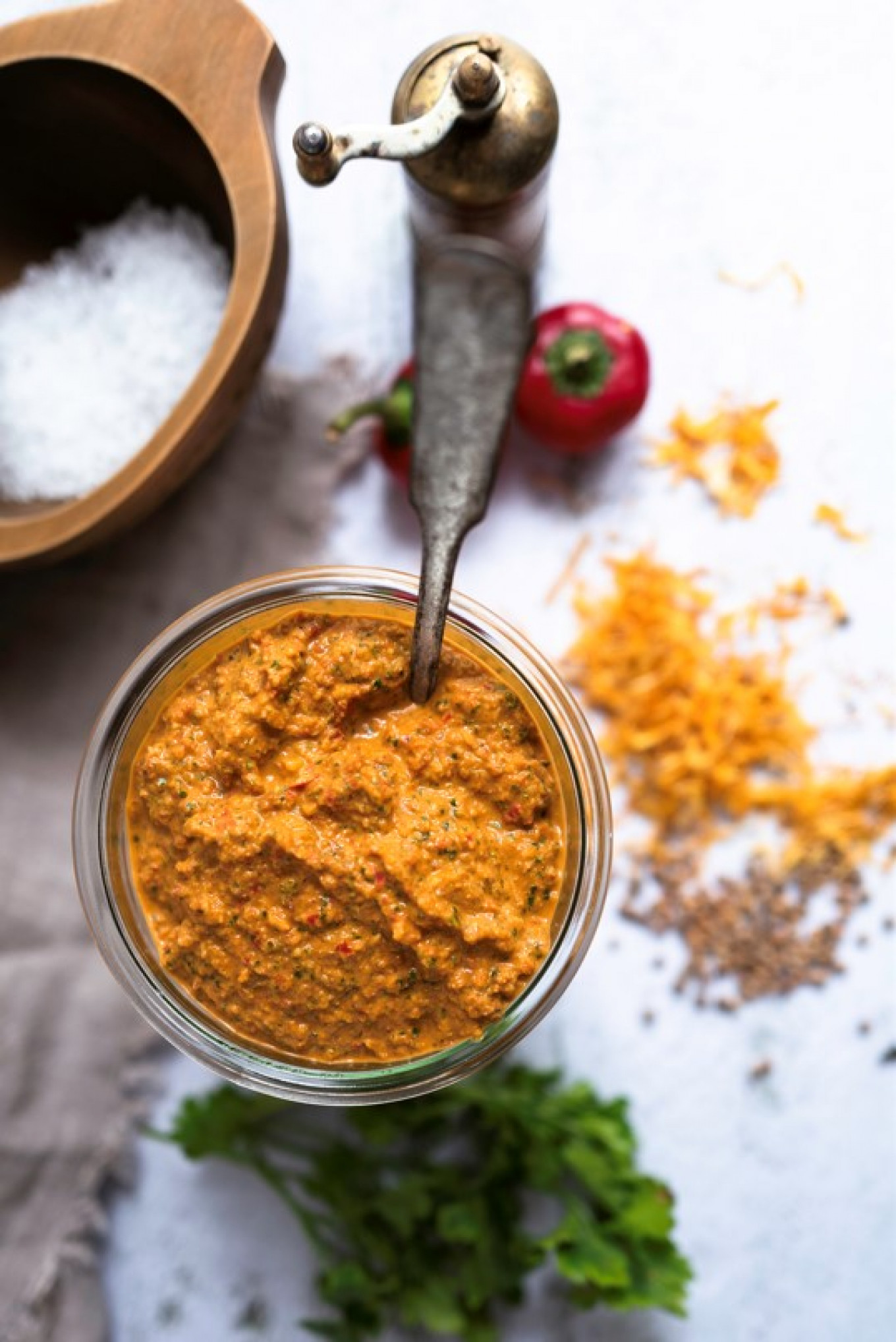
Adjika’s appeal has spread far beyond the pasturelands of Abkhazia. The spicy, salty condiment was adopted (the Abkhazians might use the word “appropriated”) by the republic’s neighbors in the region, where adjika is a popular ingredient for soups, stews, and marinades, and an essential condiment, appearing on the table to liven up everything from a dish of beans to a full lamb roasted on a spit.
As adjika traveled north through the vast Russian empire, it was further adapted with ingredients that no Caucasian would ever dream of including. In Ukraine, I have encountered “adjika” made with peppers, carrots, apples, honey, and tomatoes, while Russians add copious amounts of dill to a heavily tomato-based sauce and also call that adjika. Clearly across the years and kilometers, the word “adjika” has taken on a generic meaning for a piquant sauce or condiment.
It is just as impossible to pin down a definitive, authoritative recipe for adjika as it is one for Pesto Genovese, but the essential ingredients are red peppers (both bell and chili), salt, garlic, coriander, blue fenugreek, and calendula or dried marigold flowers. The hottest, spiciest adjika, used predominantly in cooking, is heavy on the chili peppers and their seeds: a pepper’s heat comes from its seeds, so you can always gage the relative spiciness of adjika by the number of seeds in it. Milder versions of adjika are served at table as dips or spreads, the fire dampened by the exclusion of the seeds and a generous addition of walnuts.
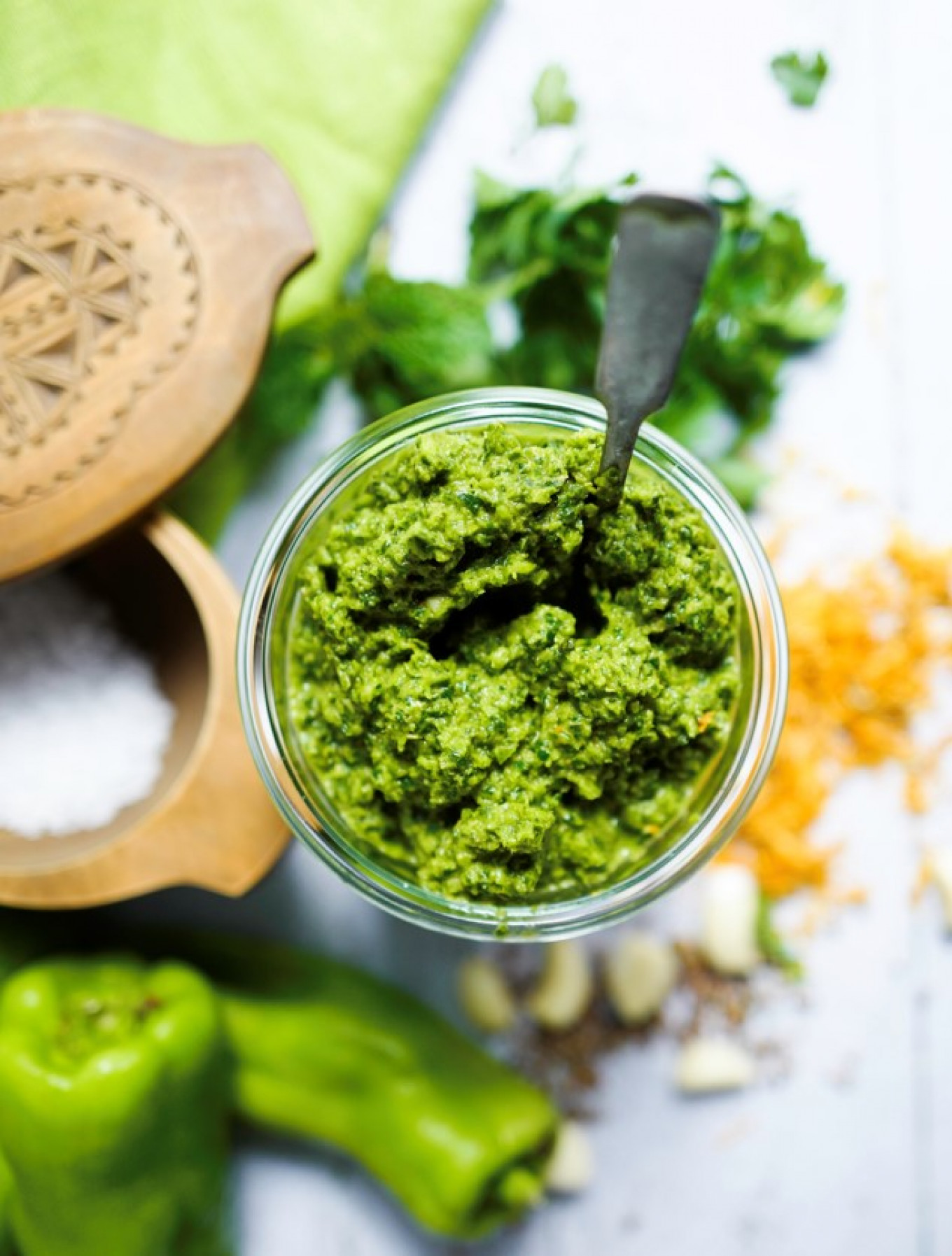
Green adjika is less common, perhaps because its key ingredients — green peppers and fresh herbs — are more perishable and thus more challenging to preserve and transport. But green adjika is no less delicious with its dominant notes of garlic and fresh herbs, making it a superb marinade for lamb, fish, and poultry. This is the adjika I turn to when all about me is cold, dark, and grey and I need a reminder of the bright sun and intoxicating air of the south.
As we grapple with faulty supply chains throughout the world, increasingly I am setting myself the challenge of making things from scratch, particularly essentials I used to pick up at retail outlets or buy online. And so it is now with adjika, which I always want to have on hand. There are so many things this versatile sauce/condiment can do, from livening up a bowl of cottage cheese to marinating pork. Pair it with leftover roast turkey or chicken as a marvelous zingy note or slather it on a well-grilled steak instead of garlic butter. I love to serve mild adjika as a dip on its own or swirled around a bowl of hummus or labneh. It is a marvelous addition to a charcuterie board, an omelet, tucked inside a pita sandwich, or on top of a side dish of grains. Stuff jacket potatoes with either one of the adjikas listed below, or dip small meatballs in a shallow bowl of either of these versions of Abkhazia’s incomparable condiment. However you choose to enjoy them, may they bring sunshine and warmth to you!
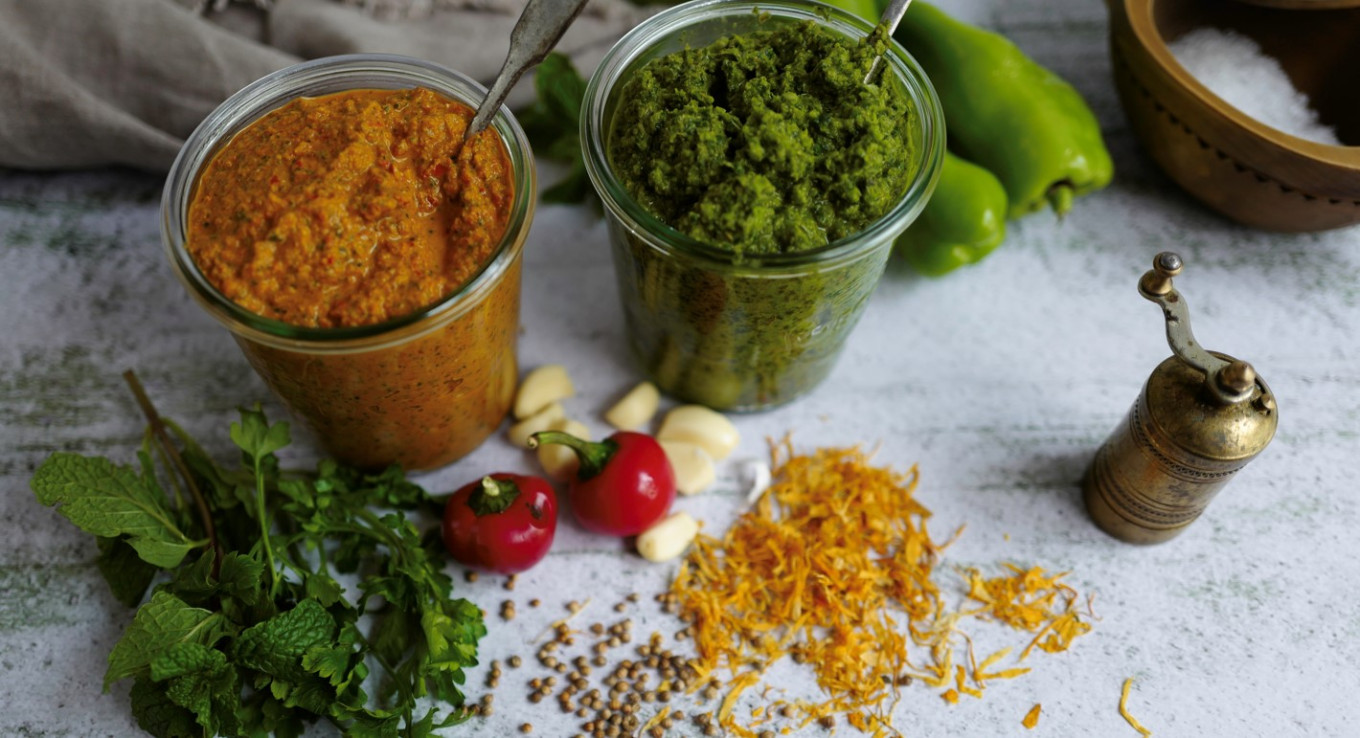
Mild Adjika with Walnuts
*Note: This milder version or adjika is primarily used as a spread rather than a sauce. Its distinctly orange color comes from the calendula or dried marjoram leaves and the addition of walnuts.
Ingredients
- 1 lb (500 grams) of a mix of chili peppers and capsicum (bell) peppers*
- 3-½ oz (100 grams) shelled walnuts
- 1-½ Tbsp coriander seeds
- 1 tsp ground cumin
- 1 Tbsp blue fenugreek**
- 1 Tbsp ground dried calendula, crushed**
- ½-cup (120 ml) chopped fresh cilantro
- 1 head of garlic, cloves peeled and roughly chopped
- 2 tsp salt
- Olive oil for storage
Preparation
- Prepare the peppers: remove the seeds if you want less heat. Be sure all the white pith is removed.
- Toast the cumin, coriander seeds and blue fenugreek in a small skillet over medium heat for 1-2 minutes until the flavors amplify. Grind in a spice grinder or crush with a mortar and pestle and set aside.
- Toast the walnuts in a small skillet for 3-4 minutes over medium heat until they brown. Take care they do not scorch.
- Place the peppers, garlic, and walnuts into food processor fitted with a steel blade and pulse until the ingredients are well combined. Add the remaining ingredients and process until the mixture resembles a wet paste or pesto. Store the mixture in a clean glass jar with enough headspace to add a shallow layer of olive oil on top, which will prevent it from discoloring. Store in the refrigerator for up to 7 days.
Green Adjika
Ingredients
- 1 lb (500 grams) of a mix of hot and sweet green peppers*
- 1 head of garlic, cloves peeled and roughly chopped
- 3-½ oz (100 grams) fresh herbs: parsley, cilantro, and mint
- 1 Tbsp blue fenugreek**
- 1 Tbsp ground coriander
- 1-½ Tbsp dried calendula leaves, crushed**
- 2 Tbsp olive oil
- 1 tsp salt
- Olive oil
Preparation
- Prepare the peppers by removing the white pith and seeds from the sweet peppers and stems and pith from the hot peppers. If you want the adjika to have more heat, leave more seeds from the hot peppers.
- Place the peppers, garlic, and spices except for the salt in a food processor fitted with a steel blade and pulse several times until the mixture is combined. Add the remaining ingredients except for the salt and process until the mixture resembles pesto or a loose sauce. Taste and add salt if desired.
- Store green adjika in a clean glass jar with enough headspace to cover the top with a shallow layer of olive oil. This will keep it from becoming discolored.
Recipe Notes
*Removing the seeds from hot peppers will make the condiment less fiery. You may wish to use protective gloves for this step and be very careful of touching your face with your hands when working with spicy peppers.
** Blue fenugreek and calendula are available from online retailers. Both are essential for that authentic aroma of the Caucuses.
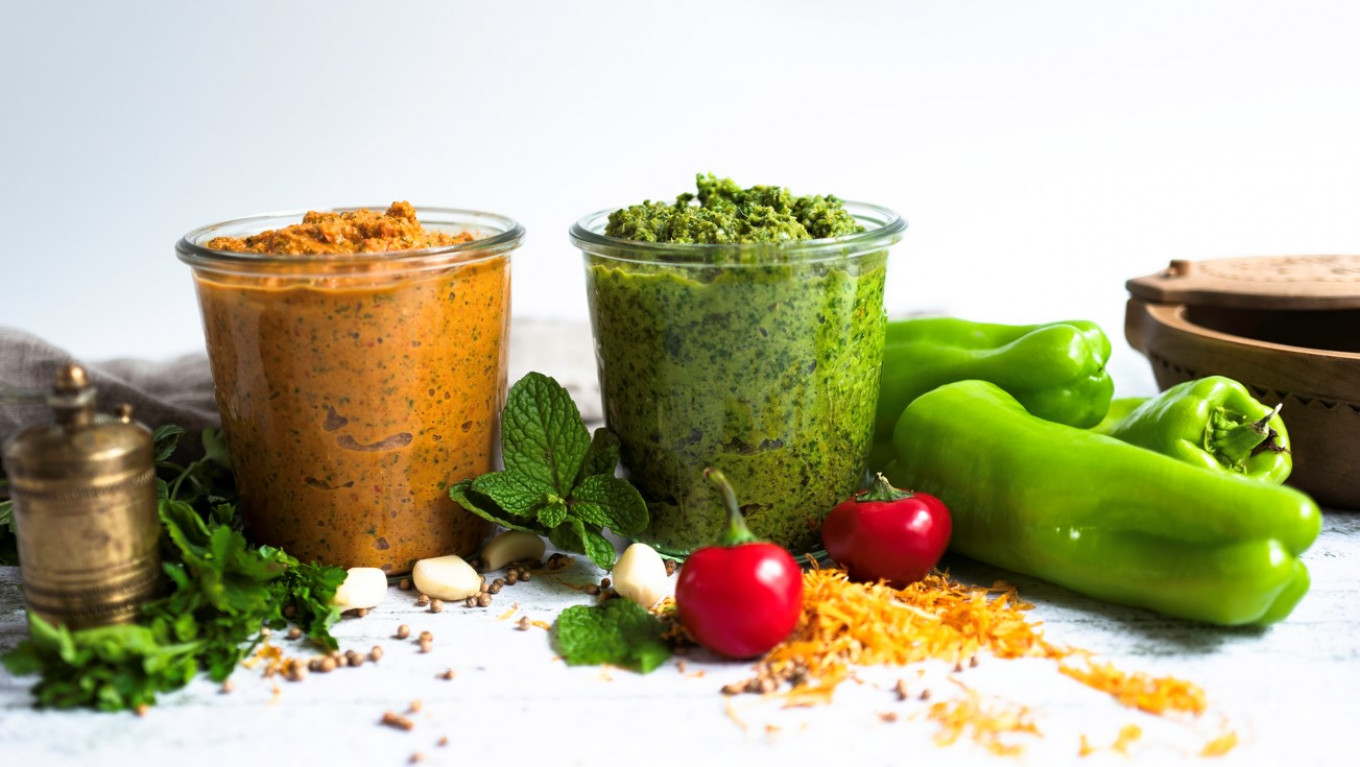
A Message from The Moscow Times:
Dear readers,
We are facing unprecedented challenges. Russia's Prosecutor General's Office has designated The Moscow Times as an "undesirable" organization, criminalizing our work and putting our staff at risk of prosecution. This follows our earlier unjust labeling as a "foreign agent."
These actions are direct attempts to silence independent journalism in Russia. The authorities claim our work "discredits the decisions of the Russian leadership." We see things differently: we strive to provide accurate, unbiased reporting on Russia.
We, the journalists of The Moscow Times, refuse to be silenced. But to continue our work, we need your help.
Your support, no matter how small, makes a world of difference. If you can, please support us monthly starting from just $2. It's quick to set up, and every contribution makes a significant impact.
By supporting The Moscow Times, you're defending open, independent journalism in the face of repression. Thank you for standing with us.
Remind me later.



